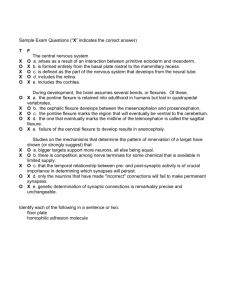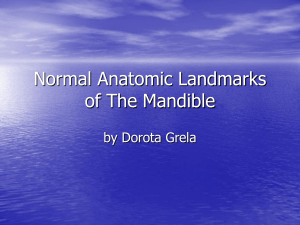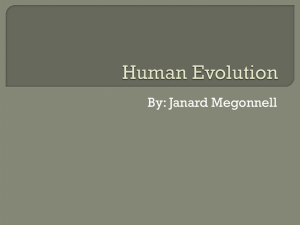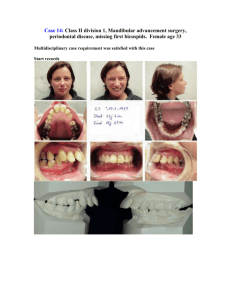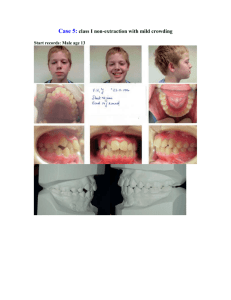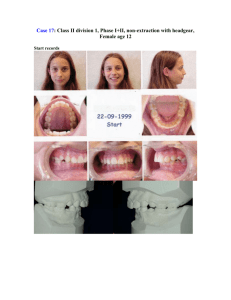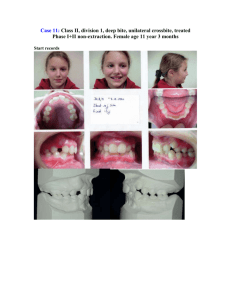- Journal of Dental Materials and Techniques
advertisement
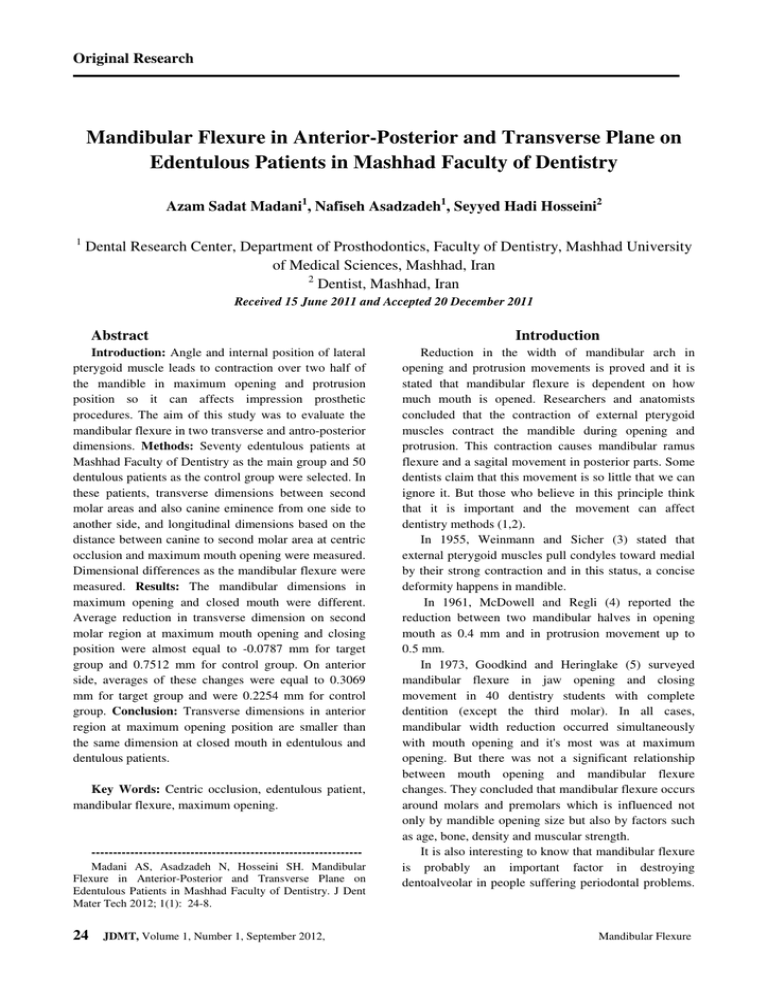
Original Research Mandibular Flexure in Anterior-Posterior and Transverse Plane on Edentulous Patients in Mashhad Faculty of Dentistry Azam Sadat Madani1, Nafiseh Asadzadeh1, Seyyed Hadi Hosseini2 1 Dental Research Center, Department of Prosthodontics, Faculty of Dentistry, Mashhad University of Medical Sciences, Mashhad, Iran 2 Dentist, Mashhad, Iran Received 15 June 2011 and Accepted 20 December 2011 Abstract Introduction: Angle and internal position of lateral pterygoid muscle leads to contraction over two half of the mandible in maximum opening and protrusion position so it can affects impression prosthetic procedures. The aim of this study was to evaluate the mandibular flexure in two transverse and antro-posterior dimensions. Methods: Seventy edentulous patients at Mashhad Faculty of Dentistry as the main group and 50 dentulous patients as the control group were selected. In these patients, transverse dimensions between second molar areas and also canine eminence from one side to another side, and longitudinal dimensions based on the distance between canine to second molar area at centric occlusion and maximum mouth opening were measured. Dimensional differences as the mandibular flexure were measured. Results: The mandibular dimensions in maximum opening and closed mouth were different. Average reduction in transverse dimension on second molar region at maximum mouth opening and closing position were almost equal to -0.0787 mm for target group and 0.7512 mm for control group. On anterior side, averages of these changes were equal to 0.3069 mm for target group and were 0.2254 mm for control group. Conclusion: Transverse dimensions in anterior region at maximum opening position are smaller than the same dimension at closed mouth in edentulous and dentulous patients. Key Words: Centric occlusion, edentulous patient, mandibular flexure, maximum opening. --------------------------------------------------------------Madani AS, Asadzadeh N, Hosseini SH. Mandibular Flexure in Anterior-Posterior and Transverse Plane on Edentulous Patients in Mashhad Faculty of Dentistry. J Dent Mater Tech 2012; 1(1): 24-8. 24 JDMT, Volume 1, Number 1, September 2012, Introduction Reduction in the width of mandibular arch in opening and protrusion movements is proved and it is stated that mandibular flexure is dependent on how much mouth is opened. Researchers and anatomists concluded that the contraction of external pterygoid muscles contract the mandible during opening and protrusion. This contraction causes mandibular ramus flexure and a sagital movement in posterior parts. Some dentists claim that this movement is so little that we can ignore it. But those who believe in this principle think that it is important and the movement can affect dentistry methods (1,2). In 1955, Weinmann and Sicher (3) stated that external pterygoid muscles pull condyles toward medial by their strong contraction and in this status, a concise deformity happens in mandible. In 1961, McDowell and Regli (4) reported the reduction between two mandibular halves in opening mouth as 0.4 mm and in protrusion movement up to 0.5 mm. In 1973, Goodkind and Heringlake (5) surveyed mandibular flexure in jaw opening and closing movement in 40 dentistry students with complete dentition (except the third molar). In all cases, mandibular width reduction occurred simultaneously with mouth opening and it's most was at maximum opening. But there was not a significant relationship between mouth opening and mandibular flexure changes. They concluded that mandibular flexure occurs around molars and premolars which is influenced not only by mandible opening size but also by factors such as age, bone, density and muscular strength. It is also interesting to know that mandibular flexure is probably an important factor in destroying dentoalveolar in people suffering periodontal problems. Mandibular Flexure In addition, clenching not only exerts extra force on teeth, it also results in mandibular flexure (6). In 1981, Omar and Wise (7) reported that mandibular flexure occurs alone by jaw muscles and in clenching, occlusal force in mandible causes the bend in lower jaw bone. In Horiuchi et al. study (8) in 1997, it was stated that mandibular body and dental arch suffer distortion due to muscle contraction during the jaw movements. The relative place between two implants connected to the jaw was surveyed in this study. The lineal distance of implants which had been placed in 10 millimeter from each other were measured by a magnetic sensor in maximum opening and protrusion in all instances. The amount of this digression in protrusion was more than maximum mouth opening. In 2000, Chen et al. (9) based on their studies stated that when lower jaw opens, mandibular arch width tends to reduce. In 2001, Tylmann (10) also supported closed bite double arch method because of the reduction of negative mandibular flexure effects in prosthetic procedures with opening mouth. In 2002, Kemkes et al. study (11) on gonial aversion and mandibular ramus flexure were as morphologic indicators of sex. The results show that age and topical tooth loss seriously reduces the accuracy of these indicators. Yet they have not been able to conclude the reliability of these two in determining sex. In 2005, Balci et al. (12) stated that in predictive accuracy of mandible to recognize the sex, ramus flexure for this indicator is more reliable in men than women. The aim of the present study is to evaluate the mandibular flexure in edentulous patients in maximum opening positions in two transverse and antro-posterior dimensions in comparison to closed mouth and its evaluation with the mandibular flexure in similar positions in 2 antro-posterior and transverse dimensions in some dentulous patients as a control group. Materials and Methods In this clinical study, a researched society consisting of 70 edentulous patients at Mashhad Faculty of Dentistry between the ages of 40 to 60 was examined. All the instances were in similar situation from the aspect of jaw relation type (class I) and the amount of lower residual ridge. It is necessary to remind those instances with TMD problems or a huge surgery record deleted from the research. The mandible dimension measurement was done in two transverse and antroposterior dimensions and the changes were recorded. Each of the measurements was done in 2 states of maximum opening and closing positions. To determine Madani et al. the anterior points (canine to canine) on the edentulous ridge, canine eminence was marked at 2 sides of mandible arch by the use of a sharp marker. Also a sign was marked at the posterior of retromolar pad at the beginning of ascending region on the edentulous ridge with a thin marker as the second molar points. To prepare a record of the patients jaw in opening state, the patient was asked to open his mouth. as open as possible, and opening amount was recorded by compound (rigid impression material) Then the patient was asked to do the swallowing and then hold his jaw for rest position. Then the distance was controlled from the aspect of ridge parallel, beauty and prosthesis MIC. Then to obtain the size of closed mouth position around 3 mm was reduced from the obtained amount which is the rest position. Then some compound was placed between edentulous ridges until it was set. We used the special gauge to measure the mandibular flexure in transverse dimension at centric occlusion from canine eminence point to the opposite canine eminence and between the second molar areas. These dimensions were also measured in maximum opening and then the changes were recorded. To measure the effects of mandibular flexure in longitudinal dimension in mouth opening and closing position in the right and left side, we used a tongue pressure to do the measurements and a sharp marker was used to demarcate it and then the changes of those positions were recorded. In this clinical study, the control group was consisted of 50 patients. All of them had class I occlusal relation and complete dentition. In order to measure the effect of mandibular flexure in transverse dimension, in maximum intercuspation position (MIP), we measured it for the second molar and inter canines distance separately. These dimensions were also measured at maximum opening. Then the changes were recorded. To measure the effect of mandibular flexure in longitudinal dimensions (antroposterior) in closed and maximum opening in the right and left side we used the tongue pressure from the distal of second molar to the distal of canine and it was marked by a sharp marker. Then, by using statistical tests of Kolmogorov-Smironof type and coupled T. Test in SPSS v. 11.5 software, the data's group and control group were examined. Results T. Test was used for surveying the changes of each differential of canine to canine distance (D.CC) and molar to molar distance differential (D.MM) and canine to molar differential in the right and the left side in each of the control and target group during opening and centric occlusion. JDMT, Volume 1, Number 1, September 2012 25 In target group, the average of canine to canine distance both in maximum mouth opening (MO.CC) and centric occlusion (CO.CC) were significant. While the average of CO.CC is more than MO.CC, in other pairs related to the test group in mouth opening position and closed position, the averages are not significantly different. But in control group not only both MO.CC and CO.CC, but also MO.MM and CO.MM Have significant differences and in other pairs related to this group, the average did not have significant difference. In Table 1, the variances related to the changes of CO and MO in the groups under the examination and control group have been compared. According to the results of the table, only the average of changes related to D.MM in the tested group was significantly more than control group. In other variances, except for D.MCR, the average of changes in the tested group has been more than control group but these differences were not significant. Discussion One of the important factors in prognostic of prosthetic treatments is to pay attention to the effect of mandible flexure during kinds of jaw movements. Mandible flexure is a result of lateral pterygoid muscle contraction over the lower jaw (3). Yet many dentists are not aware of the effect of this flexure on prosthetic treatments. The average of these dimensional changes in transverse dimension in second molar areas from one side to another side in opening and closed mouth position in target group was reported as –0.0787 and in control group as 0.7512. In transverse dimension in canine to canine region these changes were reported to be 0.3069 in target group and 0.2254 in control group. Antro-posterior dimension of the D.CC D.MM D.MC.L D.MC.R 26 mandible in transverse position in opening mouth position has decreased compared to closed mouth. In Omar and Wise (7) and McDowell and Regli’s (4) researches the measurement method has not been similar to the present research, but sill the measurements are somewhat similar to other reports. The distinction of this study lies in this point that dimensional changes resulting from mandibular flexure in anterior and posterior side were measured separately in target group who were edentulous patients and control group who were dentulous patients in similar conditions. In this study because there was no possibility to find the older patients who have measurement criteria such as intact antro-posterior teeth and without any extracted tooth dentition, we had to abandon the idea of matching instances of control group with target group. It is necessary to remind that according to Suresh research there was not significant difference in the amount of mandible flexure in comparison to other group from the aspect of age and sex. Also in this study antro-posterior dimensions of the mandible from canine region to second molar area in edentulous patients in mouth opening and closing positions in their right and left and these dimensions in dentulous patients as control group was examined and the results of the two groups were statistically compared. In examining the studies on mandibular flexure we did not encounter any research dealing with antro-posterior dimensions in edentulous patients. The difference of dimensional changes resulting from mandibular flexure in open and closed mouth position in the left and right for the instances of both groups was not statistically significant. The results showed the lengthening of longitudinal dimension from closed position to maximum opening in all tested groups. Table 1. Comparison of variance changes in two studied groups Groups Numbers Mean Standard deviation 70 .3069 1.18188 Target 50 .2254 .47356 Control 70 .07873.31905 Target 50 .7512 1.34192 Control 70 .01602.52776 Target 49 .10702.23650 Control 70 .37142.13761 Target 49 -.0143 2.49674 Control JDMT, Volume 1, Number 1, September 2012, Results 0.576 0.045 0.838 0.384 Mandibular Flexure Noticing this fact that statistical results showed significant difference in transverse dimensions in both the anterior and posterior areas in control group, it is assumed that the cause of these results points to the accuracy of measurement in each case is the effect of mandibular flexure in transverse dimension in anterior points in both groups. It should be noted that due to being fixed, availability and suitable view in the measurement of the points in instances, it was predicted that measurements have more accuracy in these cases. From the comparison of the measurements in the transverse dimension of anterior region (canine to canine) in two target and control group, it was concluded that the averages of linear changes in control group is more than those in target group and this difference on the range of 0.05 is significant for linear changes resulting from mandible flexure in transverse dimensions in anterior region and in closed mouth position. In comparing the dimensional changes of anterior region (canine to canine) in transverse dimension there was not a significant statistical difference. Also the statistical difference of dimensional changes between 2 target and control group in antro-posterior dimension was not significant. We can conclude that the differences of the two groups such as complete dentition or being edentulous and age do not have any influence on the amount of mandibular flexure in all antro-posterior dimensions in the left and right and transverse dimension of anterior area. Also the average changes resulting from mandibular flexure in edentulous patients was analyzed according to the sex factor. Based on the results it was specified that the amount of mandibular flexure in edentulous patients is not dependent on people's sex and this fact was also observed in Sunil Suresh and Vasanthkumar report (13). It seems that the effect of mandibular flexure during opening and closing mouth, we have to pay more attention to the results of these changes on the accordance of fixed prosthetic implants and dentures in edentulous patients and long bridges in dentulous patients and make an impression in minimum opening mouth. It is reasonable to advise the patients to prevent from opening the mouth more than necessary during functions. According to the results of this study, these considerations are equaled in dentulous and edentulous who volunteer to prosthetic treatment. It is suggested to survey mandibular distortion in two anterior and posterior dimensions in protrusion and lateral movements in edentulous people and the people with complete dentition. Also the influence of mandibular flexure in edentulous people in transverse dimension in posterior should be surveyed more by modern techniques such as 3 dimensional modeling. Conclusion Mandible dimensions in edentulous people changes under the effect of muscle contraction in open and closed mouth position. Age and sex do not have any significant effect in differences resulting over mandibular flexure in edentulous patients. Acknowledgment This study was supported by a research grant from the Vice Chancellor for Research of Mashhad University of Medical Sciences, Iran. It is based on Seyyed Hadi Hosseini's undergraduate thesis (No. 2284). References 1. Osborne J, Tomlin HR. Medical convergence of the mandible. Br Dent J 1964; 117: 112-4. 2. Bell G.H. The Biochemistry and Physiology of Bone. New York: Academic Press, 1956. 3. Weinmann JP, Sicher H. Bone and bones. St. Louis: C.V Mosby, 1955. 4. McDowell JA, Regli CP. A quantitative analysis of the decrease in width of the mandibular arch during forced movements of the mandible. J Dent Res 1961; 40: 1183-5. 5. Goodkind RJ, Heringlake CB. Mandibular flexure in opening and closing. J Prosth Dent 1973; 30: 134-8. 6. Fischman BM. The influence of fixed splints on mandibular flexure. J Prosth Dent 1976; 35: 643-6. 7. Omar R, Wise MD. Mandibular flexure associated with muscle force applied in the retruded axis position. J Oral Rehabil 1981; 8: 209-21. 8. Horiuchi M, Ichikawa T, Noda M, Matsumoto N. Use of interimplant displacement to measure mandibular distortion during jaw movements in humans. Arch Oral Biol 1997; 42: 185-8. 9. Chen DC, Lai YL, Chi LY, Lee SY. Contributing factors of mandibular deformation during mouth opening. J Dent 2000; 28: 583-8. 10. Tylman. Theory and practice of fixed prosthodontics. Ishiyaku EuoAmerica, 1989. 11. Kemkes-Grottenthaler A, Lobig F, Stock F. Mandibular ramus flexure and gonial version as morphologic indicators of sex. Homo 2002; 53: 97-111. Madani et al. JDMT, Volume 1, Number 1, September 2012 27 12. Balci Y, Yavuz MF, Cagdir S. Predictive accuracy of subjects–in vivo study. Degree of Master of Dental sexing the mandible by ramus flexure Homo. 2005; Surgery in Branch VI-Prosthodontics, RAGAS Dental 55: 229-37. College & Hospital, Chennai, 2005. 13. Sunil Suresh H, Vasanthkumar M. An analysis of mandibular flexure on mouth opening for dentate Corresponding Author: Nafiseh Asadzadeh Faculty of Dentistry Vakilabad Blvd, Mashhad, Iran P.O. Box: 91735-984 Tel: +98-511-8829501 Fax: +98-511-8829500 Email: Asadzaden@mums.ac.ir 28 JDMT, Volume 1, Number 1, September 2012, Mandibular Flexure
